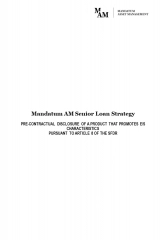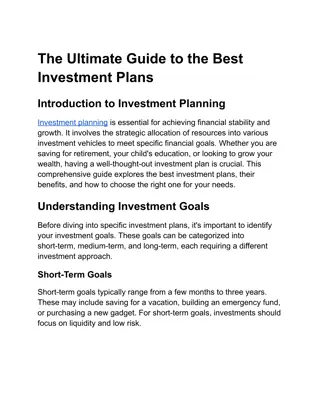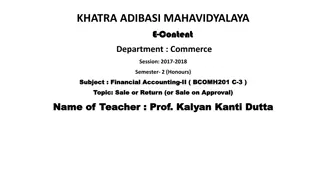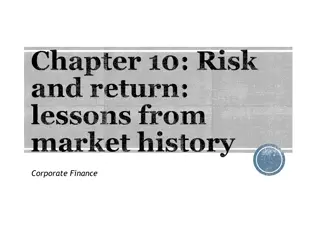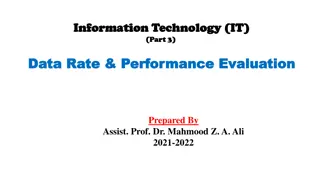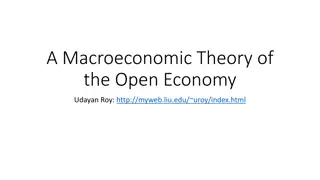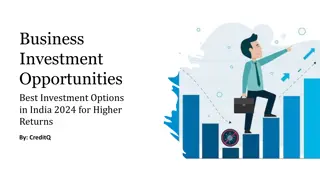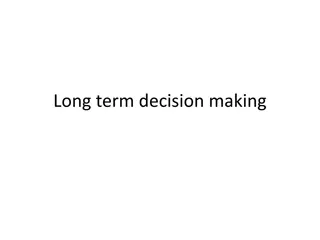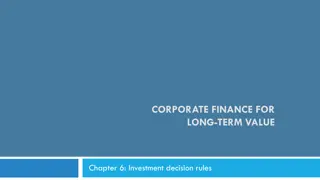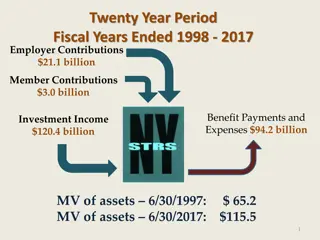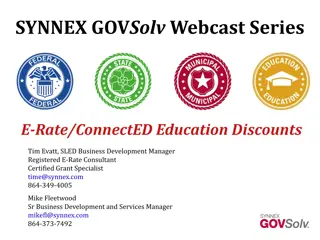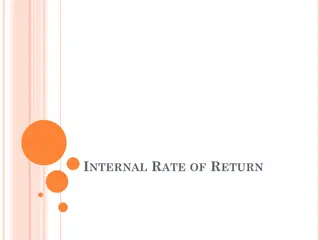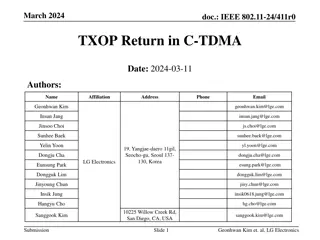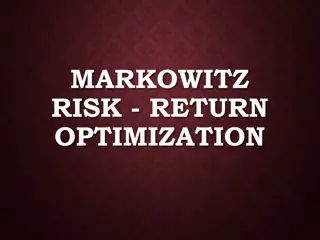Understanding the Investment Process and Rate of Return
Investors choose to invest by saving instead of spending to trade off present consumption for larger future consumption. The rate of return on an investment is measured by factors such as the pure rate of interest, time value of money, inflation impact, and risk premium. Investments involve committing funds for future returns that compensate for factors like inflation and uncertainty. Historical rates of return can be evaluated through measures like the Holding Period Return.
Download Presentation

Please find below an Image/Link to download the presentation.
The content on the website is provided AS IS for your information and personal use only. It may not be sold, licensed, or shared on other websites without obtaining consent from the author. Download presentation by click this link. If you encounter any issues during the download, it is possible that the publisher has removed the file from their server.
E N D
Presentation Transcript
An overview of the investment process
Why investors invest? By saving instead of spending, Individuals trade-off Present consumption For a larger future consumption
How Do We Measure The Rate Of Return On An Investment ? The pure rate of interest is the exchange rate between future consumption and present consumption. Market forces determine this rate. + = . 1 00 4 % . 1 04 SR SR
How Do We Measure The Rate Of Return On An Investment ? People s willingness to pay the difference for borrowing today and their desire to receive a surplus on their savings give rise to an interest rate referred to as the pure time value of money.
How Do We Measure The Rate Of Return On An Investment ? If the future payment will be diminished in value because of inflation, then the investor will demand an interest rate higher than the pure time value of money to also cover the expected inflation expense.
How Do We Measure The Rate Of Return On An Investment ? If the future payment from the investment is not certain, the investor will demand an interest rate that exceeds the pure time value of money plus the inflation rate to provide a risk premium to cover the investment risk.
Defining an Investment A current commitment of $ for a period of time in order to derive future payments that will compensate for: the time the funds are committed the expected rate of inflation uncertainty of future flow of funds.
Measures of Historical Rates of Return Holding Period Return Ending Value of Investment = HPR Beginning Value of Investment SR220 = . 1 = 10 SR200
Measures of Historical Rates of Return Holding Period Yield HPY = HPR - 1 1.10 - 1 = 0.10 = 10% 1.2
Measures of Historical Rates of Return Annual Holding Period Return Annual HPR = HPR 1/n where n = number of years investment is held Annual Holding Period Yield Annual HPY = Annual HPR - 1
Measures of Historical Rates of Return 1.4 Arithmetic Mean = AM HPY/ n where : the = HPY sum of annual holding period yields
Measures of Historical Rates of Return 1.5 Geometric Mean 1 = GM HPR 1 n where : product the = of annual the holding period returns follows as : ( ) ( ) ( ... ) HPR HPR HPR 1 2 n
A Portfolio of Investments The mean historical rate of return for a portfolio of measured as the weighted average of the HPYs for the individual investments in the portfolio. investments is
Computation of Holding Period Yield for a Portfolio # Begin Price $ $ $ Beginning Mkt. Value 1,000,000 $ 4,000,000 $ 15,000,000 $ 20,000,000 $ Ending Price 12 $ 21 $ 33 $ Ending Mkt. Value 1,200,000 $ 4,200,000 $ 16,500,000 $ 21,900,000 $ Market Wt. 0.05 0.20 0.75 Wtd. HPY 0.010 0.010 0.075 0.095 Stock A B C Total Shares 100,000 200,000 500,000 HPR HPY 1.20 20% 1.05 1.10 10% 10 20 30 5% 21,900,000 $ 20,000,000 $ HPR = = 1.095 HPY = 1.095 - 1 = 0.095 = 9.5%
Expected Rates of Return Risk is uncertainty that an investment will earn its expected rate of return Probability is the likelihood of an outcome
Expected Rates of Return 1.6 = Expected Return E(R ) i n = i 1 ( Probabilit y of Return) (Possible Return) + + + [(P i = )(R ) (P )(R ) .... (P R ) 1 1 )(R 2 2 n n n P ( ) i i 1
Risk Aversion The assumption that most investors will choose the alternative, all else being equal and that they will not accept additional risk unless they are compensated in the form of higher return least risky
Measuring the Risk of Expected Rates of Return 1.7 = Variance ( ) n = n 2 Probabilit ( y) (Possible Return - Expected Return) i 1 = i 2 P ( )[R E(R )] i i i 1
Measuring the Risk of Expected Rates of Return 1.8 Standard Deviation is the square root of the variance
Measuring the Risk of Expected Rates of Return 1.9 Coefficient of variation (CV) a measure of relative variability that indicates risk per unit of return Standard Deviation of Returns Expected Rate of Returns i = E(R)
Measuring the Risk of Historical Rates of Return n 2 HPY [ = = HPY i 1.10 = 2/n E ( HPY) i i 1 2 variance of the series holding period yield during period i expected value of the HPY that is equal to the arithmetic mean of the series the number of observations = = E(HPY) = n
Determinants of Required Rates of Return Time value of money Expected rate of inflation Risk involved
The Real Risk Free Rate (RRFR) Assumes no inflation. Assumes no uncertainty about future cash flows. Influenced by time preference for consumption of income and investment opportunities in the economy
Adjusting For Inflation 1.12 Real RFR = + 1 ( Nominal RFR) 1 + (1 Rate of Inflation)
Nominal Risk-Free Rate Dependent upon Conditions in the Capital Markets Expected Rate of Inflation
Adjusting For Inflation 1.11 Nominal RFR = (1+Real RFR) x (1+Expected Rate of Inflation) - 1
Facets of Fundamental Risk Business risk Financial risk Liquidity risk Exchange rate risk Country risk
Business Risk Uncertainty of income flows caused by the nature of a firm s business Sales volatility and operating leverage determine the level of business risk.
Financial Risk Uncertainty caused by the use of debt financing. Borrowing requires fixed payments which must be paid ahead of payments to stockholders. The use of debt increases uncertainty of stockholder income and causes an increase in the stock s risk premium.
Liquidity Risk Uncertainty is introduced by the secondary market for an investment. How long will it take to convert an investment into cash? How certain is the price that will be received?
Exchange Rate Risk Uncertainty of return is introduced by acquiring securities denominated in a currency different from that of the investor. Changes in exchange rates affect the investors return when converting an investment back into the home currency.
Country Risk Political risk is the uncertainty of returns caused by the possibility of a major change in the political or economic environment in a country. Individuals who invest in countries that have unstable political-economic systems must include a country risk-premium when determining their required rate of return
Risk Premium f (Business Risk, Financial Risk, Liquidity Risk, Exchange Rate Risk, Country Risk) or f (Systematic Market Risk)
Risk Premium and Portfolio Theory The relevant risk measure for an individual asset is its co-movement with the market portfolio Systematic risk relates the variance of the investment to the variance of the market Beta measures this systematic risk of an asset
Fundamental Risk versus Systematic Risk Fundamental risk comprises business risk, financial risk, liquidity risk, exchange rate risk, and country risk Systematic risk refers to the portion of an individual asset s total variance attributable to the variability of the total market portfolio
Relationship Between Risk and Return Exhibit 1.7 Rateof Return Low Risk (Expected) Security Market Line Average Risk High Risk The slope indicates the required return per unit of risk RFR Risk (business risk, etc., or systematic risk-beta)
Changes in the Required Rate of Return Due to Movements Along the SML Expected Exhibit 1.8 Rate Security Market Line Movements along the curve that reflect changes in the risk of the asset RFR Risk (business risk, etc., or systematic risk-beta)
Changes in the Slope of the SML RPi = E(Ri) - NRFR RPi = risk premium for asset i E(Ri) = the expected return for asset i NRFR = the nominal return on a risk-free asset where:
Market Portfolio Risk The market risk premium for the market portfolio (contains all the risky assets in the market) can be computed: RPm = E(Rm)- NRFR where: RPm = risk premium on the market portfolio E(Rm) = expected return on the market portfolio NRFR = expected return on a risk-free asset
Change in Market Risk Premium Expected Return E(R) New SML Rm' Original SML Rm RFR Risk
Capital Market Conditions, Expected Inflation, and the SML Expected Return Rate of Return New SML Original SML RFR' RFR Risk


